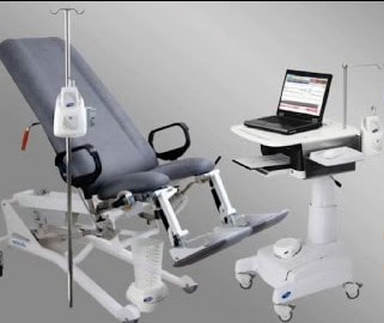
Urodynamics is a series of diagnostic tests that evaluate the function of your bladder and urethra. These tests may be recommended if you have urinary incontinence, frequent urination, recurrent bladder infections, urgent urination, slow or weak urinary stream, incomplete bladder emptying or neurologic conditions affecting the bladder. Urodynamic studies help your doctor determine the source of bladder control symptoms and the best course of treatment.
Your doctor will decide which of the following diagnostic tests should be performed to help diagnose and treat your bladder control symptoms:
- Uroflow: Measures the speed and amount of urine you void.
- Cystometrogram: Evaluates how your bladder holds urine, measures your bladder capacity, and also determines how well you can control your bladder.
- EMG: Measures how well you can control your sphincter muscles and determines if they are working in coordination with your bladder. EMG patches may be placed near your rectum to record muscle activity.
- Pressure Flow Study: Determines if there is an obstruction in your bladder or urethra.
WHAT TO EXPECT
Your urodynamics appointment will take approximately 60 minutes. Our staff will be there to guide and support you throughout your testing, answering any questions you may have and ensuring your physical and emotional comfort. You will be asked to arrive at your appointment with a comfortably full bladder for testing.
- At the start of your testing, you will empty your bladder into an uroflow meter that automatically measures the amount of urine and flow rate.
- The provider will then perform a post-void residual, which involves placing a thin tube into your bladder to measure the amount of urine remaining.
- Your urodynamic study will then begin. This study will evaluate how much your bladder can hold, how much pressure builds up inside your bladder as it stores urine, and how full it is when you feel the urge to urinate.
- Finally, the results of your study will be reviewed with you by your doctor and a course of treatment determined.
AFTER THE PROCEDURE
After the test, you may notice some discomfort when you urinate. We recommend placing a warm or cool, damp washcloth over the urethral opening for some relief or simply taking a warm bath. If you experience symptoms that are not alleviated with these simple techniques, we recommend taking an over-the-counter analgesic, such as AZO Urinary Pain Relief®. Lastly, urinary tract infections are uncommon after testing, but can occur. Please contact our office if your symptoms of burning, irritation, bladder pain or poor voiding worsen.
